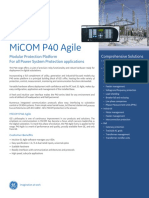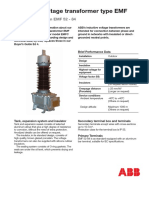Distance Protection Relay
Uploaded by
ThirumalDistance Protection Relay
Uploaded by
ThirumalDistance Protection Relay
Distance protection relay is the name given to the protection, whose action depends on the
distance of the feeding point to the fault. The time of operation of such protection is a
function of the ratio of voltage and current, i.e., impedance. This impedance between the
relay and the fault depends on the electrical distance between them. The principal type of
distance relays is impedance relays, reactance relays, and the reactance relays.
Distance protection relay principle differs from other forms of protection
because their performance does not depend on the magnitude of the current
or voltage in the protective circuit but it depends on the ratio of these two
quantities. It is a double actuating quantity relay with one of their coil is
energized by voltage and the other coil is energized by the current. The
current element produces a positive or pick-up torque while the voltages
element has caused a negative and reset torque.
The relay operates only when the ratio of voltage and current falls below a
set value. During the fault the magnitude of current increases and the
voltage at the fault point decreases. The ratio of the current and voltage is
measured at the point of the current and potential transformer. The voltage
at potential transformer region depends on the distance between the PT and
the fault.
If the fault is nearer, measured voltage is lesser, and if the fault is farther,
measured voltage is more. Hence, assuming constant fault impedance each
value of the ratio of voltage and current measured from relay location
comparable to the distance between the relaying point and fault point along
the line. Hence such protection is called the distance protection or impedance
protection.
Distance zone is non-unit protection, i.e., the protection zone is not exact.
The distance protection is high-speed protection and is simply to apply. It
can be employed as a primary as well as backup protection. It is very
commonly used in the protection of transmission lines.
Distance relays are used for both phase fault and ground fault protection,
and they provide higher speed for clearing the fault. It is also independent of
changes in the magnitude of the short circuits, current and hence they are
not much affected by the change in the generation capacity and the system
configuration. Thus, they eliminate long clearing times for the fault near the
power sources required by overcurrent relay if used for the purpose.
Application of Distance Protection Relay
Distance protection relay is widely spread employed for the protection of
high-voltage AC transmission line and distribution lines. They have replaced
the overcurrent protection because of the following reasons.
It provides faster protection as compared to overcurrent relay.
It has a permanent setting without the need for readjustments.
Direct protection relay has less effect of an amount of generation and fault
levels.
Their fault current magnitude permits the high line loading.
Distance protection schemes are commonly employed for providing the
primary or main protection and backup protection for AC transmission line
and distribution line against three phase faults, phase-to-phase faults, and
phase-to-ground faults.
You might also like
- Electrochemical Supercapacitors Scientific Fundamentals and Technological Application86% (7)Electrochemical Supercapacitors Scientific Fundamentals and Technological Application714 pages
- Over Current Relay Types and ApplicationsNo ratings yetOver Current Relay Types and Applications11 pages
- Battery Sizing Calculation Methodology: Ieee STD 485 (1997, R2003) IEEE STD 1115 (2000, R2005)100% (1)Battery Sizing Calculation Methodology: Ieee STD 485 (1997, R2003) IEEE STD 1115 (2000, R2005)7 pages
- Battery Sizing Calculation Methodology: Ieee STD 485 (1997, R2003) IEEE STD 1115 (2000, R2005)100% (1)Battery Sizing Calculation Methodology: Ieee STD 485 (1997, R2003) IEEE STD 1115 (2000, R2005)7 pages
- ABB-Calculation and Choice of Setting Values For Protection Terminals in Series Compensated System in Venezuela PDFNo ratings yetABB-Calculation and Choice of Setting Values For Protection Terminals in Series Compensated System in Venezuela PDF2 pages
- REV615 Capacitor Bank Protection and ControlNo ratings yetREV615 Capacitor Bank Protection and Control6 pages
- Cewe Digital Programmable Transducer User Manual Cewe BGX5 PDFNo ratings yetCewe Digital Programmable Transducer User Manual Cewe BGX5 PDF64 pages
- Chapter 5 Protection Coordination-Objectives and Methodology PDFNo ratings yetChapter 5 Protection Coordination-Objectives and Methodology PDF13 pages
- Haryana Vidyut Prasaran Nigam LTD.: Technical SpecificationNo ratings yetHaryana Vidyut Prasaran Nigam LTD.: Technical Specification39 pages
- Test Feasibility For Various EquipmentsNo ratings yetTest Feasibility For Various Equipments10 pages
- Operation Manual: Feeder Protection Relay REF615No ratings yetOperation Manual: Feeder Protection Relay REF615120 pages
- P-100H P-100H P-100H P-100H: Temperature Controller Temperature Controller Temperature Controller Temperature ControllerNo ratings yetP-100H P-100H P-100H P-100H: Temperature Controller Temperature Controller Temperature Controller Temperature Controller11 pages
- Ref 542 Plus Installation CommissioningNo ratings yetRef 542 Plus Installation Commissioning80 pages
- Material Specifications Cell: Technical Specification OFNo ratings yetMaterial Specifications Cell: Technical Specification OF8 pages
- Self-Powered Feeder Protection REJ603: Application ManualNo ratings yetSelf-Powered Feeder Protection REJ603: Application Manual76 pages
- Busbar Protection REB670 Version 2.2 IEC: Commissioning ManualNo ratings yetBusbar Protection REB670 Version 2.2 IEC: Commissioning Manual178 pages
- Technical Manual, Busbar Protection REB650 Version 2.2No ratings yetTechnical Manual, Busbar Protection REB650 Version 2.2656 pages
- Component Tests: Insulation Test SystemNo ratings yetComponent Tests: Insulation Test System12 pages
- Relays - Advancement of Adaptive Relaying in Power Systems Protection PDFNo ratings yetRelays - Advancement of Adaptive Relaying in Power Systems Protection PDF44 pages
- R-MAG Instruction Book 1VAL255101-MB Rev ENo ratings yetR-MAG Instruction Book 1VAL255101-MB Rev E52 pages
- Guideform Specification - Transformer Protection Relay: Micom P40 Agile P642, P643, P645No ratings yetGuideform Specification - Transformer Protection Relay: Micom P40 Agile P642, P643, P64515 pages
- VLF Sine 0.1 HZ - Universal Voltage Source For Test-Ing and Diagnostics of Medium-Voltage CablesNo ratings yetVLF Sine 0.1 HZ - Universal Voltage Source For Test-Ing and Diagnostics of Medium-Voltage Cables9 pages
- Uploads Product Rishmaster EM3490 1PH Manual PDFNo ratings yetUploads Product Rishmaster EM3490 1PH Manual PDF2 pages
- Feeder Protection: by - Harshit Sharma ENROLLMENTNO.-41114804915No ratings yetFeeder Protection: by - Harshit Sharma ENROLLMENTNO.-4111480491527 pages
- 7SR242 Duobias Complete Technical Manual PDF100% (1)7SR242 Duobias Complete Technical Manual PDF359 pages
- Site Test Reports: SL No Equipments Test Equipments Type of Test (Installation) Type of Test (Commissioning) RemarksNo ratings yetSite Test Reports: SL No Equipments Test Equipments Type of Test (Installation) Type of Test (Commissioning) Remarks2 pages
- Working Principle of Distance or Impedance RelayNo ratings yetWorking Principle of Distance or Impedance Relay16 pages
- Transformer Protection and Transformer FaultNo ratings yetTransformer Protection and Transformer Fault3 pages
- Principle of Weak InFeed Echo Permissive Over Reach Transfer Trip SchemesNo ratings yetPrinciple of Weak InFeed Echo Permissive Over Reach Transfer Trip Schemes6 pages
- Abc de FC BGHC I JHDKBLC MC Noe P o JQC IgrsktbNo ratings yetAbc de FC BGHC I JHDKBLC MC Noe P o JQC Igrsktb5 pages
- Akiqja: - QR C. DR QJBR B. Abckq) R XR Ms. S. Afr Bjaukiq. at CQMTBJBZ Tkbir P G Abop WNo ratings yetAkiqja: - QR C. DR QJBR B. Abckq) R XR Ms. S. Afr Bjaukiq. at CQMTBJBZ Tkbir P G Abop W1 page
- Mechanical Effects of Short-Circuit Currents Analysis On Autotransformer WindingsNo ratings yetMechanical Effects of Short-Circuit Currents Analysis On Autotransformer Windings4 pages
- Forces and Motion: Basics: Lab InstructionsNo ratings yetForces and Motion: Basics: Lab Instructions4 pages
- Practical Guide: This Practical Guide Contains Important Information About Your PracticalNo ratings yetPractical Guide: This Practical Guide Contains Important Information About Your Practical11 pages
- Part I: Introduction and Basic Concepts: 1.1 Definition Fluid MechanicsNo ratings yetPart I: Introduction and Basic Concepts: 1.1 Definition Fluid Mechanics18 pages
- Performance Analysis of H5 Topology of Transformerless InverterNo ratings yetPerformance Analysis of H5 Topology of Transformerless Inverter6 pages
- Electric Charges and Fields Practice Sheet Uthaan NEET 2024No ratings yetElectric Charges and Fields Practice Sheet Uthaan NEET 20247 pages
- Neutral Voltage Protection - 59GN - 95% Stator Earth Fault Protection - Electrical4uNo ratings yetNeutral Voltage Protection - 59GN - 95% Stator Earth Fault Protection - Electrical4u2 pages
- Piezoelectric Materials For High Power H PDFNo ratings yetPiezoelectric Materials For High Power H PDF5 pages











































































































